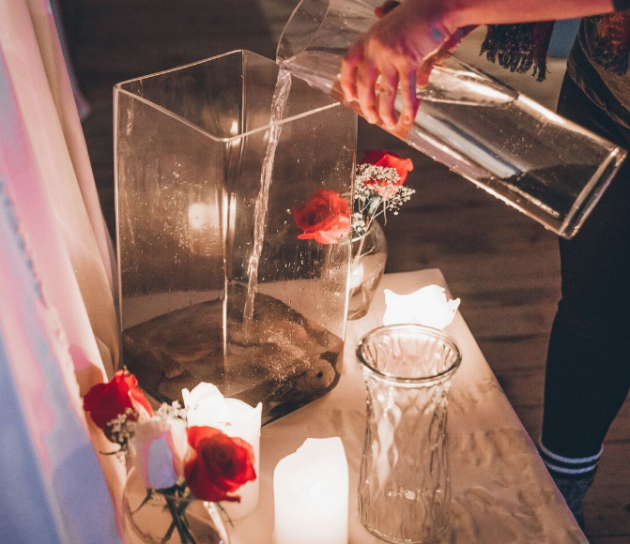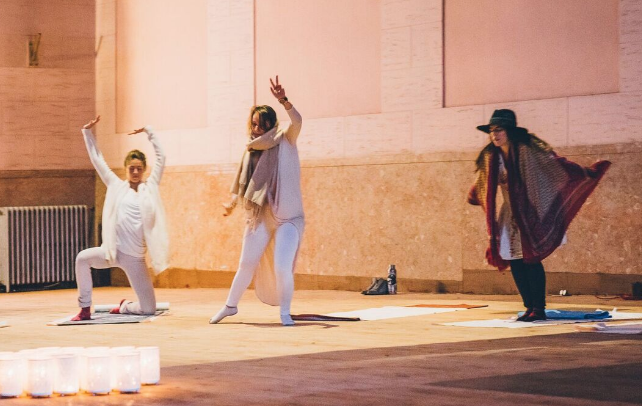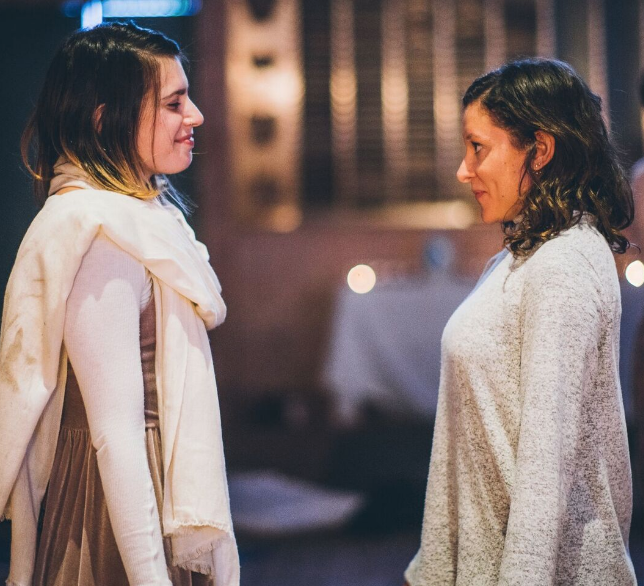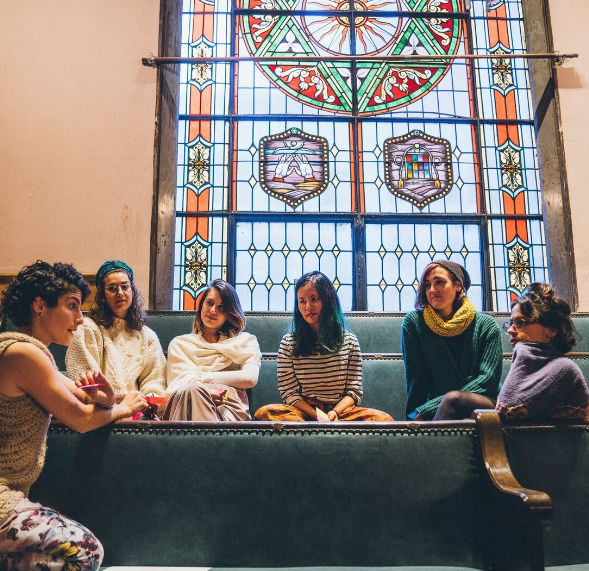The Lilith Blog 1 of 2
November 28, 2017 by Rebecca Krevat
Feeling Alive Within Jewish Rituals

Photo credit: Inna Shnayder
We should be playing more.
This is the formative idea behind the Well of Wills Ritual Lab. Hannah Roodman, an artist and experience designer from Richmond, Virginia developed the concept of the Well of Wills, “intimate and immersive experiences designed to help boost creativity and strengthen self-trust.” Last December I journeyed with Hannah for the first Well of Wills retreat, where 30 Jewish women spent a weekend in the Hudson Valley for workshops to explore the concept of divine Jewish femininity, and empower ourselves through creativity. We were divided into groups, and by the end of the weekend each group had created a unique performance piece on topics ranging from vanity to jealousy. We also participated in a photo series considering our past, present and future selves, ate wholesome and delicious food, danced and connected with each other. It was pure magic.
When Hannah invited me to join the next installment of the Well of Wills series, a day of experiences designed to “explore how personal and co-created prayer and ritual can impact change in our daily lives,” I jumped on the opportunity to play some more.
Hannah talks about the concept of the Well of Wills so assuredly, as if the project has always been inside of her. She tells me that her concept was inspired by who we are as women, that we are wells of will, wells of desire with unbounded potential, as we sit in the balcony surrounded by stained glass of the beautiful Emunat Yisrael synagogue on 23rd street in Manhattan. Below us candles are still flickering, and post-it notes with words and phrases like, “I am enough,” “I am a human being, not a human doing” and “Breathe more,” are sprinkled across the floor. The fruits of the day’s exploration are scattered, and each participant—about 25 of us altogether, women who see themselves as spiritual leaders, many Jewish but not all—takes home with her a version of a siddur, a traditional Jewish prayer book. The siddur is broken up into four different themes: grounding, emptiness, creativity, and abundance. Within each of those themes there are guiding prompts, mantras, questions to explore, and rituals to take on. On one of the introductory cards it is written: “This is a companion to tradition, not a replacement. This siddur offers a multitude of prompts for inner reflection and asks: Can prayer be brushing your hair? Exfoliating? Playing loud music? Having a meaningful conversation with a friend?” The siddur is a unique work of art in itself.

Photo credit: Inna Shnayder
Our day last week day began with a meditation exercise starting in stillness, imagining ourselves in a desert and later imagining ourselves in a well filled with water, and moving as if we were the water ourselves. After lunch we broke into groups that corresponded with the four pillars included in the siddur. My group was “grounding,” and we discussed the types of things that prevent us from feeling grounded in our lives. While we each have had our own personal experiences, and some of us were feeling more grounded than others in that moment, common themes were fear of not living up to our potential, anxiety that we are lacking in some way, and an inability to “let go.” We then put together a short performance, physically embodying what it feels like both to feel grounded and completely out of control. After the performances, we debriefed and discussed how we could bring some of what we learned about ourselves from the performances into our daily lives. Using the siddurs as inspiration, we drew up our daily schedules to find the places where we got stuck during the day, where we could possibly integrate some meaningful but practical rituals.
We are living in a time where we need play like this more than ever. In this political and global turmoil, we are constantly being bombarded by horrific news, by glittering screens and loud, hateful opinions. As Hannah explained to me, although it may seem like social media gives more opportunity to express ourselves creatively, it often backfires for many people: “If man is made in god’s image, then we are meant to be creators, that’s where fulfilment comes in to a great extent. Yet we are living in an unprecedented time of exposure to others, and competition in many ways makes us less safe to express… It’s sacred within itself to create.”

Photo credit: Inna Shnayder

Photo credit: Inna Shnayder
Hannah, and the other artists who developed the Ritual Lab—Nessa Norich, Mati Engel, Meirav Ong, and Danielle Friedman—seek to bring the godly aspect of creating, of creativity for the sake of our own self-worth and wellbeing to the participants of the day. As Nessa described, “it’s what makes us feel nourished as human beings…it’s what keeps us feeling alive and engaged, questioning, reactive, responsive, playful.”
For adults there are too few places where we are able to stretch our imaginations, play pretend or color outside of the lines. This can lead us to feeling down. As Mati explains, “I think a lot of feeling stuck has to do with feeling not creative or not generative, and I don’t mean generative in the capitalist sense of product, but rather that you have anything new to bring to the conversation and to the table, and I think that’s something that a lot of women struggle with. So for me, I think I find godliness in the ability to create and to manifest something that didn’t exist before in space and time, and that’s really powerful.”
For Jews, rituals govern our lives. There are rituals for eating, sleeping, going to the bathroom, and even which shoe to put on first. For the artists I spoke to, being Jewish is inextricable from the concept of creativity, from this project and from ritual itself. As Nessa explained, “we derive our spirituality from a Jewish origin, all of us are equally interested in updated ritual, not to not be Jewish but in order to make it relevant and potent and important and valuable for our sanity and wellbeing.” Mati described a similar sentiment related to the Jewishness of the Well of Wills, “a lot of this is a response to what Judaism hasn’t been offering, embodiment, creativity, aliveness with ritual, agency in ritual, movement, inspired by what’s lacking in our structure so far, but some of the values are still present.”

Photo credit: Inna Shnayder
Hannah described this workshop to me as a gift to those who were participating, but the project expands to far greater heights than just the women in the room. As Nessa describes, “It feels timely and important for women to get together and spark the sisterhood, enliven the sisterhood, it feels like that is the future and there is so much potential for things for when people get together. That is the most threatening thing for any establishment, people talking and that needs to happen more, and we need spaces for it and more opportunity for creating things.”
We are living in a radical moment in history, where current events are pushing for change in ways that have been so needed for centuries. If we can bring creativity and play into our own lives, perhaps we can spark some magic to change the world.
The views and opinions expressed in this article are the author’s own and do not necessarily reflect those of Lilith Magazine.
 Please wait...
Please wait...